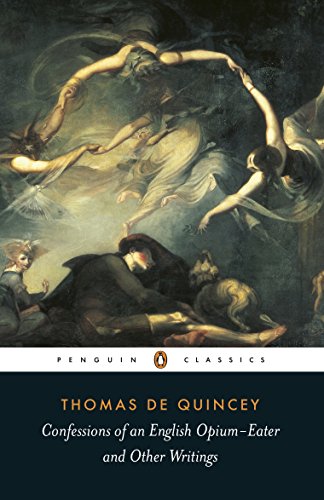Thomas De Quincey
New York
Penguin Classics
2003
88 Pages
According to the Art:
In this literary memoir of his opium addiction, Thomas De Quincey writes of the pleasures and pains opium brought him over an eighteen–year period during the early 1800s. His experiences foretell journalistic accounts of the opioid addiction crises that occurred two hundred years later.
Synopsis:
Thomas De Quincey was a British writer—essayist, mostly—during the first half of the nineteenth-century. He is best known for writing about his personal experiences with opium, which appeared in two sequential issues of London Magazine in 1821, and then published as this book in 1822. He would later write a sequel, and later still a more elaborated version of the original.
De Quincey’s first encounter with opium was in 1804 when he was eighteen-years-old. Opium was freely available then and was often consumed for recreational purposes. De Quincey was not seeking it for pleasure, at first. Based on a friend’s recommendation, after suffering excruciating facial and head pain for twenty days, De Quincey tried opium to relieve the pain. He acquired opium in the form of a tincture (laudanum) from a local druggist (“unconscious minister of celestial pleasures!”). (p. 43) The book covers the subsequent eighteen years of his opium use, though he would use it until the end of his life at age seventy-four.
De Quincey refers to opium as the “dread agent of unimaginable pleasure and pain.” (p. 42) The book is organized accordingly. After describing his early years of straitened circumstances including near starvation, he divides the book into sections on “the pleasures of opium,” and “the pains of opium.”
The pleasures De Quincey found in opium came with his first dose in 1804, pleasures that extended past the pain relief it provided.
But I took it: – and in an hour, oh! Heavens! what a revulsion! what an upheaving, from its lowest depths, of the inner spirit! what an apocalypse of the world within me! That my pains had vanished, was now a trifle in my eyes: – this negative effect was swallowed up in the immensity of those positive effects which had opened before me – in the abyss of divine enjoyment thus suddenly revealed.
p. 44
For more of these pleasures, De Quincey drank laudanum over the next ten years at a frequency he describes variously as “occasionally,” “at intervals,” and “seldom…more than once in three weeks: this was usually on a Tuesday or a Saturday night.” He learned that some time was needed between “several acts of indulgence in order to renew the pleasurable sensations,” a property of opioids pharmacologists would later call tolerance. (pp. 8-9)
De Quincey eventually became familiar with the pains of opium when the return of severe intestinal pains he suffered in his “boyish days” made it necessary that his laudanum use become “an article of daily diet,” (p. 9) because he “could no longer resist,” and “could not have done otherwise” (p. 59). The amount of opium De Quincey consumed as a result was enough to cause severe reactions when he tried to reduce his dose: “It is a state of unutterable irritation of the stomach…accompanied by intense perspirations, and feeling such as I shall not attempt to describe without more space at my command.” (p. 70)
Though relieving pain was the initial reason for his daily diet of laudanum, for most of the next eight years, avoiding withdrawal reactions became the more important motivation for De Quincey’s laudanum intake: “it was solely by the tortures connected with the attempt to abjure it, that it kept its hold.” (p. 86) He eventually knew he had to quit when he realized: “I must die if I continued the opium: I determined, therefore, if that should be required, to die in throwing it off.” (p. 87) Throwing off opium was not easy for De Quincey as he experienced “torments of a man passing out of one mode of existence into another,” (p. 88) but he claims he was ultimately successful.
Analysis:
Published accounts of opioid addiction during the first two decades of the 2000s have parallels with De Quincey’s account published two hundred years earlier in two ways. The first pertains to how people become addicted to opioids when they are acquired for pain relief, and the other to how people once addicted seek them to prevent the horrors of withdrawal more than for pain relief or pleasure.
Opium would come to De Quincey when he wasn’t looking for it specifically, but through a friend when he needed pain relief, only to become addicted. Beth Macy, in her 2018 book, Dopesick, documents a similar scenario at work in the opioid crisis she writes about. Many of the people she was following were not looking for opiods at the time they needed pain relief, but opioids came to them nevertheless, and not through a friend as in De Quincey’s case, but through a health care system suddenly awash in them. At that time, opioid use had expanded from treating only people with severe pain from terminal cancers to treating people with about any cause of moderate, self-limited pain, and people with various chronic pain syndromes.
De Quincey spoke of opium’s power to generate an other worldly experience from the first time he ingested laudanum: “Here was a panacea for all woes: here was the secret of happiness, about which philosophers had disputed for so many ages, at once discovered.” (p. 44) Macy finds a young person who expresses a similar other worldly experience with the first heroin injection in describing it “like shooting Jesus up in your arm. It’s like this white explosion of light in your head. You’re floating on a cloud.” (p. 136)
Macy also talked to many people who had the same experience as De Quincey in finding out about their addiction when they first tried to reduce their doses or quit the drugs altogether. One of them told her she needed to keep using opioids because “you’ll do anything to make the pain go away,” (p. 41) which corresponds with De Quincey’s admission that his continued use of opium “was not for the purpose of creating pleasure, but of mitigating pain in the severest degree.” (p. 9) De Quincey’s account is more than of just historical significance because his experiences echo the experiences people report with opioid addiction in Macy’s more contemporary account.
As water finds its own level, opioids find their own users, and then drowns them. This was true in De Quincey’s time, and it’s true two hundred years later when opioid addiction became the most frequent cause of death in the United States for people under the age of fifty years.
Also:
A version of this post is at the NYU Literature, Art and Medicine Database.



